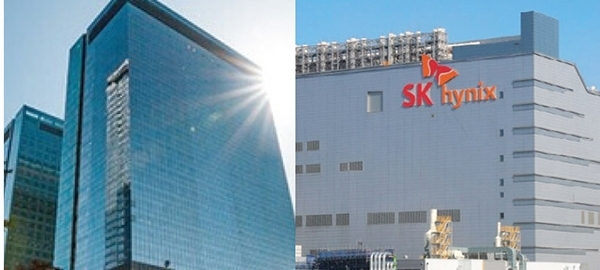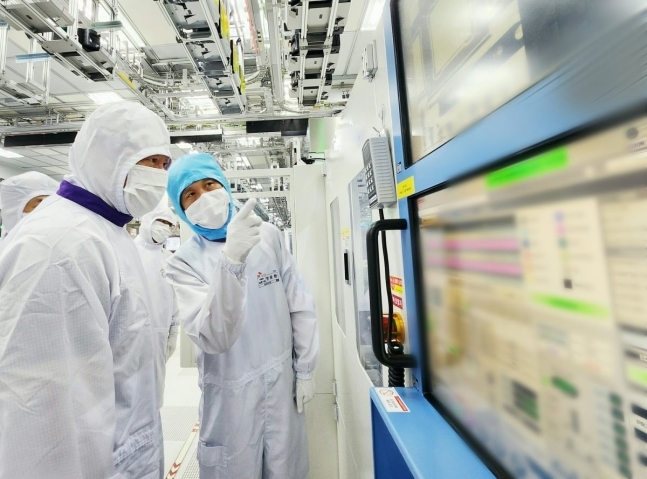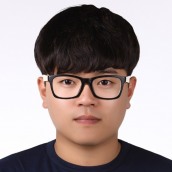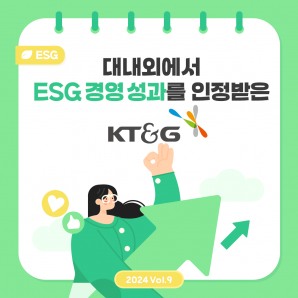
Samsung Electronics' Seocho office building (left) and Hynix's Icheon headquarters (right) / Photo from each company
According to Samsung Electronics and SK Hynix on 13th August, the two companies will start mass production of HBM4, the next-generation HBM product, next year. HBM is categorized into generations based on the level of stacking technology (stacking) of memory. Up to now, up to the fifth generation has been commercialized.
5th generation HBM3E is taking the lead by supplying about 90% to Nvidia, which monopolizes AI semiconductors, after SK Hynix succeeded in commercializing it for the first time in the world in March. According to market research firm Trendforce, SK Hynix is expected to take the top spot in the global share of HBM in terms of shipments this year with about 53%.
2nd place (42% share) Samsung is currently undergoing HBM3E performance testing from Nvidia and is expected to begin mass production later this year.
Samsung Electronics, which has lost its pride in SK Hynix, which it considered to be one step below it in the memory market, plans to turn the tables in the competition for HBM4 leadership. As Nvidia, which has a 98 percent monopoly in the global AI semiconductor market, releases new AI GPU 'Rubin' in 2026, it plans to quickly secure supply. Nvidia plans to install HBM4 in Rubin for the first time.
In particular, industry observers believe that Samsung will have an advantage because HBM4 requires a finer process and specific components and designs than previous products. Up to the HBM3E, the HBM was arranged horizontally around the GPU but, HBM4 is characterized by its increased computational speed by vertically stacking HBMs on top of GPUs. In this case, the 'logic die', an essential part that connects the GPU and HBM, requires foundry (semiconductor contract manufacturing) capabilities.
Samsung Electronics is the only all-in-one company in the global semiconductor market with its own memory, foundry, and packaging capabilities. This means that Samsung Electronics has strengths in cost reduction, productivity, and customized strategies compared to SK Hynix, which outsources production to Taiwanese foundry company TSMC.
"We are developing HBM4 with the goal of launching it in the second half of next year," said Kim Jae-joon, head of strategic marketing(Vice President) at Samsung Electronics' memory division, in a conference call on the 31st of last month. "We are discussing detailed specifications with our customers, such as developing customized products to meet customer-specific HBM demand, and will respond in a timely manner based on our supply capabilities."

SK Group Chairman Choi Tae-won who visited SK Hynix's Icheon headquarters on the 5th Aug. / Photo by SK Hynix
On the other hand, SK Hynix plans to strengthen its technology super gap strategy, such as expanding investment and early commercialization, based on its market share.
SK Hynix is known to have placed an order for equipment to expand the M16 plant in Icheon, which is under construction as a state-of-the-art DRAM plant. The plant produces general-purpose DRAMs used in various AI and electronic devices, including next-generation HBMs.
Prior to this, SK Group announced its plan to invest about 103 trillion won in strengthening HBM competitiveness with SK Hynix over the next five years by securing an additional 80 trillion won by 2026 along with the AI-centered rebalancing declaration in June.
Chairman Choi Tae-won said, "SK Hynix is now recognized in the HBM market, but we should not settle for the present as competition will become fiercer when 6th generation HBM is commercialized next year. We should focus on securing technological competitiveness without shaking and think fiercely about next-generation products." "Let's commercialize 6th generation HBM early next year to protect Korea's AI semiconductor leadership and contribute to the national economy."
Kim JaeHun (rlqm93@fntimes.com)





























![[DQN] "지자체 금고 잡아라"…출연금 신한 1위·금고 규모 농협 압도적](https://cfnimage.commutil.kr/phpwas/restmb_setimgmake.php?pp=006&w=69&h=45&m=5&simg=2024112102061902156f09e13944d391241172.jpg&nmt=18)
![[DQN] ‘잠잠할 날 없는 금융사고?’ 3년간 6천억대...BNK금융, 사고금액 최대](https://cfnimage.commutil.kr/phpwas/restmb_setimgmake.php?pp=006&w=69&h=45&m=5&simg=2024112211120005687237391cf861151384944.jpg&nmt=18)
![[DCM] KT, 2000억 회사채 발행... 장기 자금조달로 재무 안정성 확보](https://cfnimage.commutil.kr/phpwas/restmb_setimgmake.php?pp=006&w=69&h=45&m=5&simg=2024112113555900183141825007d12411124362.jpg&nmt=18)




![[DCM] "한화오션, 공모채 경쟁률 8.4대 1… 효성첨단소재도 목표액 초과"](https://cfnimage.commutil.kr/phpwas/restmb_setimgmake.php?pp=006&w=69&h=45&m=5&simg=2024112210235807058141825007d12411124362.jpg&nmt=18)















![[카드뉴스] 국립생태원과 함께 환경보호 활동 강화하는 KT&G](https://cfnimage.commutil.kr/phpwas/restmb_setimgmake.php?pp=006&w=298&h=298&m=1&simg=202403221529138957c1c16452b0175114235199_0.png&nmt=18)
![[카드뉴스] 신생아 특례 대출 조건, 한도, 금리, 신청방법 등 총정리...연 1%대, 최대 5억](https://cfnimage.commutil.kr/phpwas/restmb_setimgmake.php?pp=006&w=298&h=298&m=1&simg=20240131105228940de68fcbb35175114235199_0.jpg&nmt=18)
![[카드뉴스] 어닝시즌은 ‘실적발표기간’으로](https://cfnimage.commutil.kr/phpwas/restmb_setimgmake.php?pp=006&w=298&h=298&m=1&simg=202311301105084674de68fcbb35175114235199_0.png&nmt=18)
![[신간] 사모펀드 투자와 경영의 비밀](https://cfnimage.commutil.kr/phpwas/restmb_setimgmake.php?pp=006&w=81&h=123&m=5&simg=2024102809331308730f8caa4a5ce175114235199.jpg&nmt=18)
![[신간]퍼스널브랜딩, 문학에서 길을 찾다](https://cfnimage.commutil.kr/phpwas/restmb_setimgmake.php?pp=006&w=81&h=123&m=5&simg=2024102214123606876f8caa4a5ce175114235199.jpg&nmt=18)
![[서평] 추세 매매의 대가들...추세추종 투자전략의 대가 14인 인터뷰](https://cfnimage.commutil.kr/phpwas/restmb_setimgmake.php?pp=006&w=81&h=123&m=5&simg=2023102410444004986c1c16452b0175114235199.jpg&nmt=18)

![[신간] 김국주 전 제주은행장, ‘나는 시간을 그린다 1·2’ 에세이 출간](https://cfnimage.commutil.kr/phpwas/restmb_setimgmake.php?pp=006&w=81&h=123&m=5&simg=2024111517430908074c1c16452b012411124362.jpg&nmt=18)








